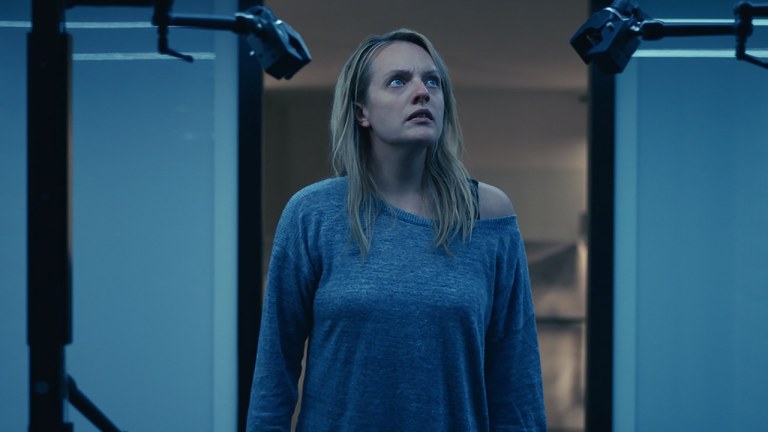The Invisible Man Ending Explained
We unpack how things played out during The Invisible Man's twisty ending and what it means for Cecilia...

This The Invisible Man article contains spoilers. Our spoiler-free review can be found here.
Freedom. That’s what Cecilia Kass finally achieves during the last moments of Leigh Whannell’s The Invisible Man. With her face isolated in an extreme close-up, there is nowhere for audiences to look other than into the heart of Elisabeth Moss’ eviscerating performance. Here is a woman who had been victimized by an abusive boyfriend but has now turned the tables, emancipating herself from Adrian Griffin (Oliver Jackson-Cohen). With her dog at last in tow, she can begin her life as the hero of her own story.
Cecilia reached this liberation through the most delicious of final twists. After it was revealed that Adrian’s brother Tom (Michael Dorman) was allegedly the Invisible Man who haunted and tortured Cecilia—to the point of killing her sister Emily (Harriet Dyer) and framing Cee for the murder—Cecilia went to break bread with the “innocent” Adrian. After all, Adrian appears to police to be a victim too, locked in his own basement for weeks. So she returns to Adrian’s house of horror she fled in complete terror a month ago, even agreeing to have dinner with her manipulative ex. Yet when she walks away from the table to go into their bedroom, Adrian appears on camera to slit his own throat with his steak knife: committing suicide in the exact same way Emily was murdered.
Of course, it wasn’t suicide, though. Cecilia beat Adrian at his own game, going into the bedroom to clean herself up after a supposed breakdown, and then returning in the invisible suit she hid in her and Adrian’s bedroom closet earlier in the movie. She then used it to kill the bastard and mock him with the same word he said after she was committed to a mental hospital following Emily’s death: “Surprise.”
Indeed, Adrian was certainly the Invisible Man who bedeviled her for the majority of the film. As Cee tells her friend James (Aldis Hodge), Adrian is always trying to make her look like “the crazy one.” Hence his methodical slow-burn torment that alienated everyone in her life, culminating in the framed murder of her sister. And the fact he said “surprise,” which is revealed to be a common mind game he played with Cee when they were together. It was that admission—as well as Tom’s insistence while wearing his lawyer hat that she have Adrian’s baby—that more than confirms Adrian’s guilt. He knows Cee is aware that Tom’s a “jellyfish,” he just thought he could somehow gaslight her one last time.
It turned out he was wrong. Cee apparently planned her revenge since well before Emily’s death. During the sequence where she visits Adrian’s house and hides the invisible suit, I like many wondered why she didn’t keep it, using the hardware to prove to her sister and the cops she wasn’t hysterical. But, as it turns out, she always intended to take matters into her own hands by feigning a reconciliation. Adrian just made it much harder to pull off by committing murder.
Admittedly, this ending does strain credulity in several ways. For example, Adrian knew Cee was hiding in their closet earlier in the movie, but he nor Tom was ever curious enough to search the space for where she hid the spare invisible suit, which they would have undoubtedly noticed was missing while playing their games. Additionally, why would Tom make it look like Adrian was his prisoner before going to kill James’ daughter? It’s a pretty hard pill to swallow that he’d allow for a main plan, or even a contingency, where he is killed or arrested while murdering a little girl. And if Tom didn’t make it look like Adrian was tied up… well, even Houdini couldn’t tie his own knots around his wrists.
But quibbles aside, the potency of the ending is how it conveys through pulpy genre conventions the familiar nightmares of abuse survivors. Once again, the men in Cee’s life don’t believe her when she says she was attacked by her violent boyfriend. They make excuses for Adrian or point out that it just doesn’t seem like he could do that—even physically in the case of Adrian being tied up. While James at least seems to accept that Cee is probably right in knowing it was Adrian who repeatedly assaulted her, he’s only reached that place because he’s seen Adrian (and his brother) also attack James’ own daughter. Only when he personally knows a family member who has been attacked by violent men does James fully believe Cee… all the while conceding the law won’t do anything to help her.
To be fair, James proves to be an ultimately good ally and helps set-up the alleged sting operation where Cee wears a wire and tries to get Adrian to confess. But in truth, she knew relying on laws that are designed to protect rich and powerful men like Adrian was a long-shot. She hopes the wire can be enough, but she went into that house with the revenge-killing always being her Plan A. Hence saying they should eat steak instead of sushi or pasta.
The steak knife being naturally on the table, and her being recorded on James’ wire and on Adrian’s camera as going to the bathroom creates the perfect alibi while Adrian’s throat is slit. She then makes sure she is nice and visible on camera when she calls 911. The patriarchy’s records should be satisfied. But after crying for the lens, she steps out of frame, becoming effectively invisible. As The Invisible Man shows time and again, invisibility can be its own power, allowing one to show their true face. Surprise, asshole.
